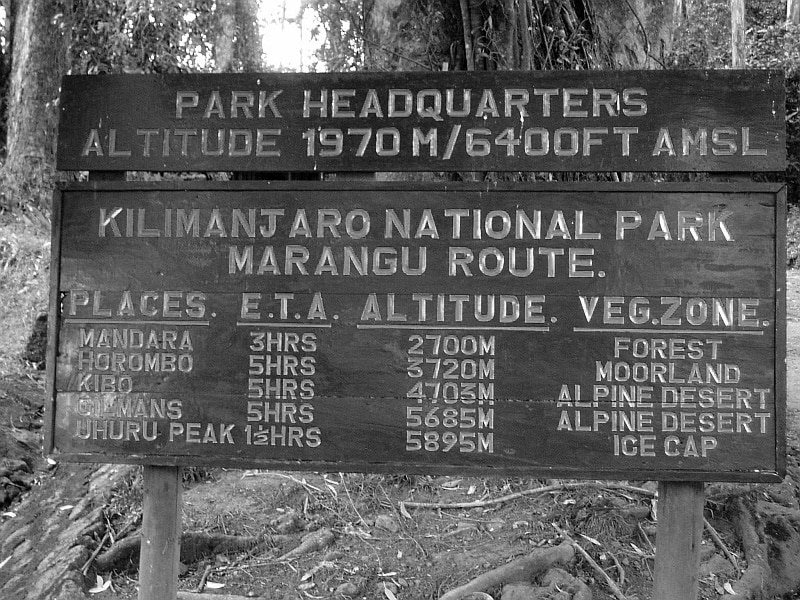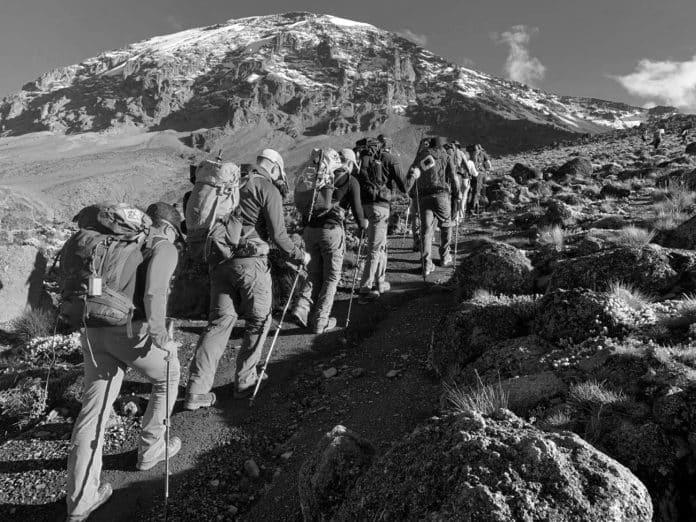Answer – How Long Does It Take to Climb Mount Kilimanjaro?
Inquiries concerning how long it takes to climb Mount Kilimanjaro are common. The longer routes to the summit of Mount Kilimanjaro’s Uhuru peak take between five and nine days to complete. The better your odds of making it to the top are, the more time you spend acclimatizing on the mountain. The summit success rate for hikers who spend fewer than five days on the trek is the lowest.
There is a far better chance of summiting for trekkers who spend at least eight or nine days on the climb. You can discover more about the best routes to ascend Kilimanjaro and the number of days required.
Kilimanjaro Summit Times are Affected by a Variety of Factors
Because it’s a “walk-up” mountain, no special climbing skills are required to summit Kilimanjaro. For the most part, the amount of time you spend at the summit is controlled by how quickly you adjust to the shortage of oxygen in the air at a high altitude.
Acclimatization
Acclimatization is the most common reason climbers fail to make it to the peak of Mount Kilimanjaro.
How Committed Should You to Make It to the Top? Acclimatization is the main obstacle if you’re determined to accomplish the climb.
If you take it slow and steady, your body will eventually acclimatize and get used to the lack of oxygen.
The better your odds of making it to the top are, the more time you spend acclimatizing on the mountain. Less than five days of trekking on Kilimanjaro has the lowest success rate, while eight to nine days of trekking has a significantly greater success rate.
Exactly How Long Does It Take to Climb Up Mount Kilimanjaro?
It is “a very effective strategy of avoiding altitude illness,” said the practice guidelines for preventing acute altitude illness published by the Wilderness Medical Society.
While physical fitness doesn’t affect how efficiently you acclimate, you’ll need germane rest and recovery time following the day’s trip.
Despite the difficulty in obtaining statistics from the Kilimanjaro National Park, estimates of the success rate based on the number of days spent on the mountain were evident as far back as 2006.
Stats Show, There Were:
Only 27% of hikers who took the shorter 5-day walk made it to the top, compared to 86% of those who took the longer 8-day trek.
Due to better guides, a greater understanding of hiking the trail, and better gear, It’s important to recollect that time on the mountain is essential.
There is no correlation between being physically fit and an increased ability to adjust to new situations. Physical fitness will ease the trek, reducing fatigue and strain, but it will not aid in acclimatization.
According to the Institute for Altitude Medicine, Dr. Hackett said, “physical fitness will not protect you from altitude illness.” Occasionally, many young, fit people will ignore key warning signs and push via distress.
Which Route Up Mount Kilimanjaro Takes the Longest?
Mount Kilimanjaro has six unique routes.

The Marangu or Umbwe Routes are the fastest ways to the summit. It is not advised for most hikers, but you can accomplish them in five days or less.
Six to ten days are required for the longest treks, such as Lemosho, the Northern Circuit or Rongai, and Machame.
Aside from altitude adjustment, there are several more reasons for taking a long route.
If you aren’t in top physical condition, traveling the same distance in less time puts you at a greater danger of exhaustion and injury and reduces your enjoyment of the scenery.
Walking Up Kilimanjaro, How Long Does It Take to Complete?
A longer route or acclimatization days are recommended by Climbing Kilimanjaro for hikers with a flexible schedule to ensure an easier summit attempt.
As a result, each route has a different duration on the mountain and various types of dwelling, difficulty, and landscapes.
Using the list below, you can see how many days it takes to finish each route.
The route, the number of days, and the total distance traveled are all listed below:
- The Marangu route (40 mi): Five days excursion, 64 kilometers.
- The Umbwe Route (23 mi): Six days excursion, 37-kilometers.
- The Rongai route (23 mi): Six or seven days excursion, 65 kilometers.
- The Machame route (30 mi): Six or seven days excursion, 49 kilometers.
- The Lemosho Route (35 mi): Seven, eight, or nine days excursion, 66 kilometers,
- The Northern Circuit (35 mi): Eight or 9-day excursion, 66 kilometers.
Kilimanjaro Can be Climbed in Days, But is the Risk Worth It?
Five or six days should be enough time to climb Kilimanjaro. Clients that prefer shorter routes for the following reasons have come forward:
- Cost-cutting measures.
- A lack of vacation days.
- Long-distance hiking isn’t something of interest in doing.
A smooth, gradual climb to the top of Mount Kilimanjaro is safer for our clients and increases their chances of reaching the summit, which is why our mountain guides and trek organizers advocate for it.
Allowing time to admire the beautiful mountain environment and taking adequate rest and recovery breaks will enhance the experience.
What Things to Consider to Climb Mount Kilimanjaro?
For your consideration, we ask and encourage you to think about the following:
For example, imagine returning on day three because the ascent rate was too quick and you didn’t have enough acclimatization time for the route; you had planned to take the fewest number of days possible?
To maximize your chances of reaching the peak and reduce the strain on your body, wouldn’t you like to extend your journey by a few days?
What Savings’ does not take additional days to mean in terms of your trip’s length, peak-missing, or worst-case scenario health risks?
When is It Reasonable to Skip a Lengthier Climb Up Mount Kilimanjaro?
Having traversed to a high altitude, some pre-acclimatization and the ability to take a speedier route are advantages of having mounted Mt Kenya, or Meru.
Climbing at high altitudes (over 18,000 ft) and being confident in your ability to acclimatize are prerequisites for this route.
Longer routes have a better success percentage than shorter ones.
When Descending From Mount Kilimanjaro, How Long Does It Take?
From the summit of Uhuru Peak to the Finish Line on Kilimanjaro, the descent usually takes two days. Depending on the terrain and the trekkers’ experience, the descent can take up to five hours to reach the night’s camp and four to six hours the following day.
Mount Kilimanjaro’s Fastest Ascent Times by Elite Athletes
To climb Kilimanjaro, you’ll need at least four days.
The current Record-holder:
After four hours and 56 minutes, Karl Egloff summited. Since then, he has set new records on the likes of Aconcagua and Cotopaxi. Please find out more about his intense training and pre-acclimatization routine here.
The following are some more notable occurrences:
- Women with the fastest summit times are a 6:52-hour Mweka route for Kristina Schoo Madsen (Denmark).
- The fastest unassisted attempt is held by Tanzanian Simon Mtuy. Nine hours and 19 minutes of carrying his gear, including food and water, on Umbwe’s path.
- The earlier record-holder, Kilian Jornet, took 7 hours and 14 minutes to reach the summit.
How Long Do You Think It Will Take You? Do you Think You Can Summit Kilimanjaro?
The Kilimanjaro climbing adventure is a once-in-a-lifetime opportunity, but at the same time don’t put your safety or success at risk.
Just find a tour operator for climbing mount Kilimanjaro and explore these questions in further details.
For more articles related to Things to Do in Tanzania (Zanzibar), click here!































